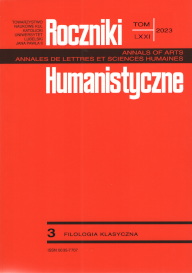Znaczenie gajów Orku w Eneidzie Wergiliusza
The Meaning of the Orcus Groves in Virgil’s Aeneid
Author(s): Marta Czapińska-BambaraSubject(s): Language and Literature Studies, Studies of Literature, Other Language Literature, Philology
Published by: Towarzystwo Naukowe KUL & Katolicki Uniwersytet Lubelski Jana Pawła II
Keywords: Virgil; Aeneid; Orcus; myrtle; Julius Caesar; laurel; Octavian Augustus
Summary/Abstract: The underground land called Orcus presented in the Aeneid is covered by two great woodlands: a myrtle forest and a laurel grove. The aim of this article is to establish what hidden meanings these types of trees can have and what Virgil communicated through them. A study of the symbolism of the myrtle shows its links with the goddess Venus Genetrix, whom poets presented as “the mother of the Aeneads” and with whom Julius Caesar credited his kinship. An analysis of the meaning of the laurel points to Apollo, and consequently to Octavian, who popularized the idea of this god’s particular endorsement of his person. The use of these symbols recognized in the social consciousness helped Virgil create their coherent image in Book VI of the story about the formation of the Roman State. By placing the two great groves in the land of Orcus, first the myrtle growing in the Fields of Sorrow, i.e. at the beginning of the road which crossed the Underground, and then the laurel at its final stage in Elisium, he portrayed the path which the Roman State went through, starting with the regime of Julius Caesar and culminating with the reign of Augustus. In view of the fact that Virgil placed both forests in the land of Dreams, in a poetic way he gave this scene the character of a prophetic vision which is about to be realized.
Journal: Roczniki Humanistyczne
- Issue Year: 71/2023
- Issue No: 3
- Page Range: 43-57
- Page Count: 15
- Language: Polish

